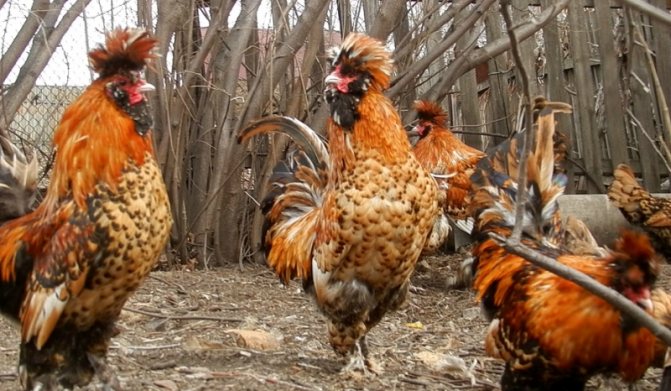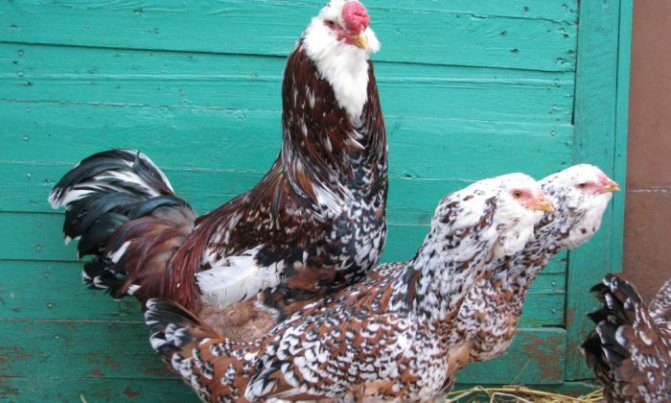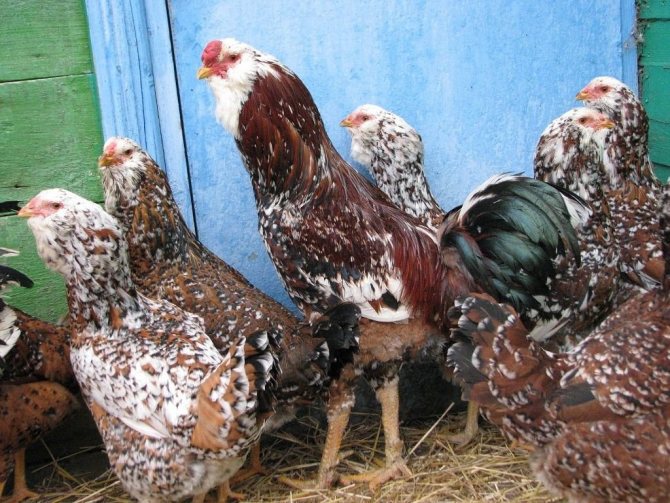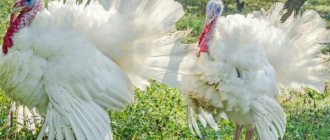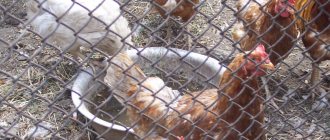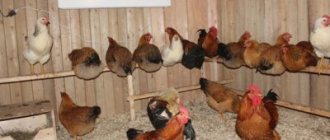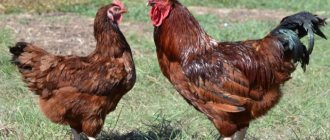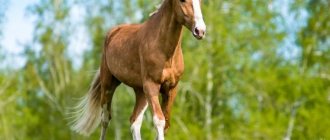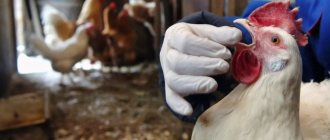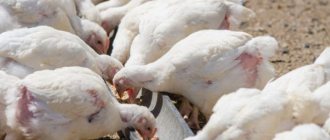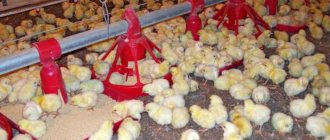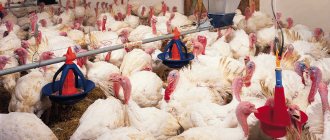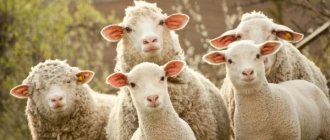About selection
Count Orlov-Chesmensky (favorite of Catherine II) became famous not only for breeding beautiful Oryol horses. The chickens bred under his supervision were also named after the count. Events date back more than two centuries.
The Malay fighting and Persian birds, characterized by a strong character, variegated plumage and a bearded look, took part in the formation of the breed. Through the efforts of the count, this breed became widespread in the 19th century practically throughout the entire European territory of the state. The Russian Imperial Society of Poultry Breeders announced the standard parameters of the Oryol bird in 1914.
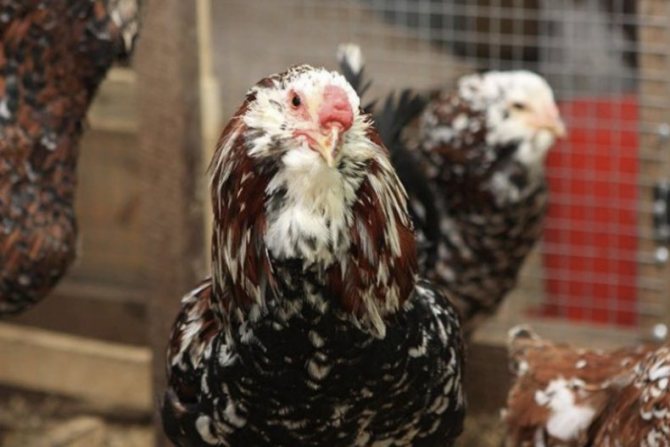
The All-Russian Scientific Research and Technological Institute of Poultry Keeping in the collector's collection this breed as a genetic fund (reserve).
Description and features
The breed developed in the 19th century meets the requirements of its time. Cold winters and damp weather are tolerated by the bird. Egg production practically does not fall, which is important given the high cost of eggs in winter. And the meat is endowed with a pleasant unconventional taste. Representatives of the breed are unpretentious to living conditions and food feed. But chickens are sensitive to cold and bad weather, as they slowly grow and fledge. They require special attention and approach.
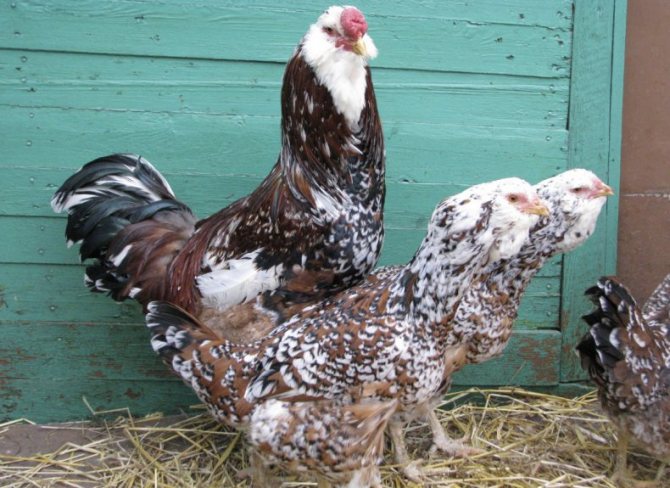

Appearance and physique
Roosters have the following features:
- the body is raised, slender, vertical;
- legs are elongated, hardy, yellow without plumage;
- the neck is long with a bend;
- skull with a wide, flat occipital bone and overhanging superciliary arches;
- the chest is slightly convex;
- beak short, curved, yellow (predator species);
- the plumage of the neck and nape forms a lush layer;
- the crest is small, crimson, with inconspicuous tubercles;
- the tail of medium length is directed upwards and consists of beautiful feathers;
- reddish-amber eyes set deep;
- the lobes and earrings are small red, hidden under the beard and buns.
Chickens are distinguished by a squat appearance and horizontal orientation of the figure, as well as a tail that is not so bright and short.
Color
Only after two years do the representatives of the breed become fully developed and enchant with true beauty. The color of orlovok varies widely. Black and white are of the same color. Scarlet individuals are endowed with a reddish-brown head and a black back, body and chest. The most popular color is calico.


Red-black-white blotches are found throughout the plumage of these birds. There is the following bird color:
- scarlet (red, nutty) brown-breasted;
- scarlet (red, nutty) black-breasted;
- white;
- clayey (yellow);
- mahogany brown-breasted;
- mahogany black-breasted;
- striped;
- spotted red-white;
- calico (red-black-white);
- black.
German breeders have bred a dwarf branch of the Orlov breed, which is represented by white, red and calico colors.
Character
Orlovka chickens are distinguished by their peaceful, balanced character. Roosters are aggressive and do not miss the opportunity to show strength and fighting qualities. It is interesting that the breed also attracts with its outstanding appearance and beauty.
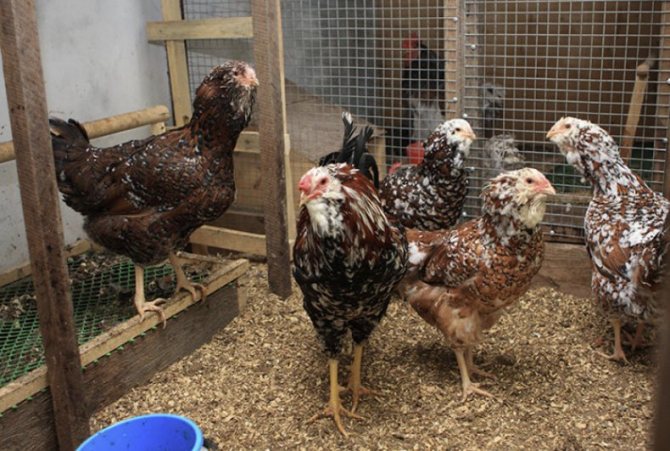

Incubation instinct
It is impossible to make a brood hen out of them, since the instinct of incubating eggs is completely absent. And an incubator is needed to breed young animals.
Productive qualities
The meat and egg productivity of the breed lies mainly in obtaining meat, since egg production is significantly lower than meat indicators.
Egg production and when they start to lay
The growth of the young is unhurried. Oryol layers give their first eggs at 7-8 months of age. Their number reaches an average of 145 pieces per year. The second year is characterized by a drop in egg production. The egg weighs 58-60 g, the shell is painted in white and light cream tones. Chickens of chintz color give the shell a pale pink color. Orlovka is not suitable for the production of eggs on an industrial scale.
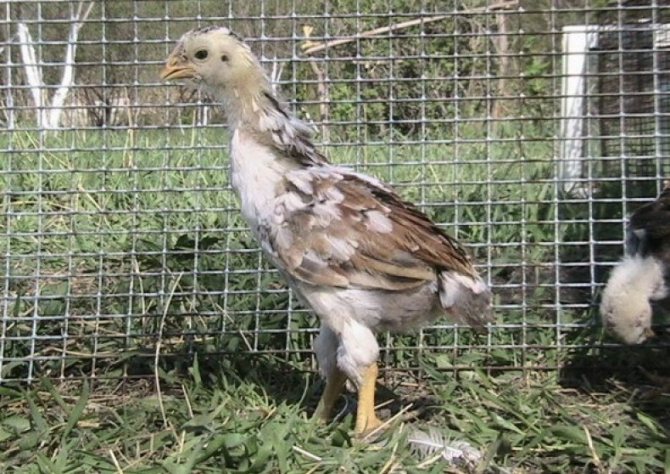

Early maturity and taste of meat
Representatives of the breed reach early maturity by two years of life. The weight of the rooster reaches 4-4.5 kg, chicken - 3 kg. The meat of the Oryol bird is endowed with a pleasant taste of game, although a little harsh. It has a small amount of internal fat, which is so typical for wild birds. So the breeders emphasized the external and internal similarity with wild relatives successfully.
Purchase of breeding material
As we said above, despite the many advantages of this breed, it is not bred on a large farm and industrial scale.
This family of birds is considered to be a very rare species that is threatened with complete extinction. They are bred only by people who are fond of poultry farming. It is they who sell the breeding material and know all the intricacies of breeding.
On the territory of the Moscow and Saratov regions, there are several farms that make hatching eggs to order.
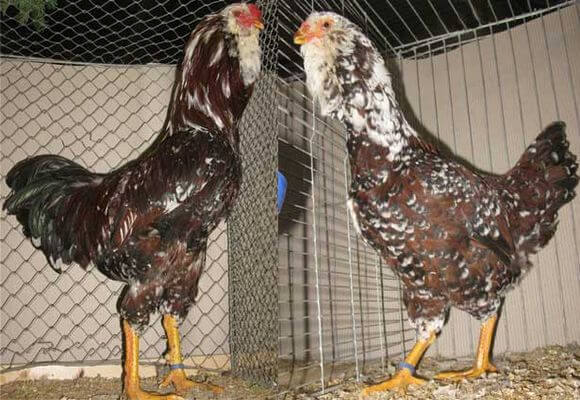

What to feed
A curved short beak is considered when purchasing feeders and drinkers. The bird should easily take feed and drink water. Do not forget to regularly put small pebbles and sand in the feeders. Chicks require improved nutrition and special attention, as they are prone to colds, beak curvature, weak legs.
Chicks
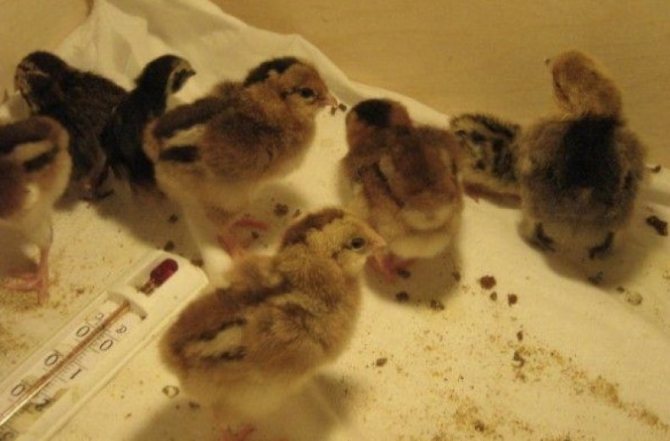

The presented scheme correctly organizes the feed ration of chickens:
- 1-5th day - chopped boiled egg or cottage cheese with corn flour or boiled millet;
- 5-10 days - wet mash on the skim milk. The mash is based on special compound feed, wheat bran, chopped greens, boiled carrots;
- from the 1st to the 10th day, feeding is carried out 6-7 times at knocks;
- from the 10th to the 30th day - 4-5 times;
- from the 30th day - 3 times.
Daily water changes improve the well-being of small birds.
Adult chickens
Adults are undemanding to the diet and will eat any composition of the feed. But for the satisfactory development and immunity of the breed, a balanced high-quality diet is required. The menu includes:
- grain mixtures (wheat and barley (30% each), buckwheat (5-10%), millet and seeds (10%), corn (10%));
- compound feed;
- bran;
- vegetables (carrots, beets, potatoes, cabbage);
- cut grass, nettles (in summer).
Advantages and disadvantages
Let's briefly emphasize the advantages and disadvantages of the Oryol breed.
Advantages:
- decorative, extraordinary appearance;
- high vitality;
- meat productivity due to high body weight;
- exquisite taste of meat product.
Disadvantages:
- late maturation of layers;
- difficulty in nursing and poor chick survival;
- low egg production;
- exactingness to a balanced diet.
Difficulties in breeding the breed of Oryol chickens lie in a special attitude to nutrition, nursing chickens. Adults are unpretentious, requiring only more freedom of movement and normal conditions of detention.
Breed benefits for poultry breeders
Oryol chickens are considered almost the most suitable for breeding in cold regions. Farmers of Siberia and other territories with a harsh climate give preference to the Orlovs, since these birds adapt well to frosty winters without losing productivity.
Two key advantages - egg and meat productivity, also add to the advantages of the Orlov breed.The birds are large, so the yield of dietary meat from one individual is also great, and the numerous eggs that the laying hens give will provide the whole family with food and organize a small business.
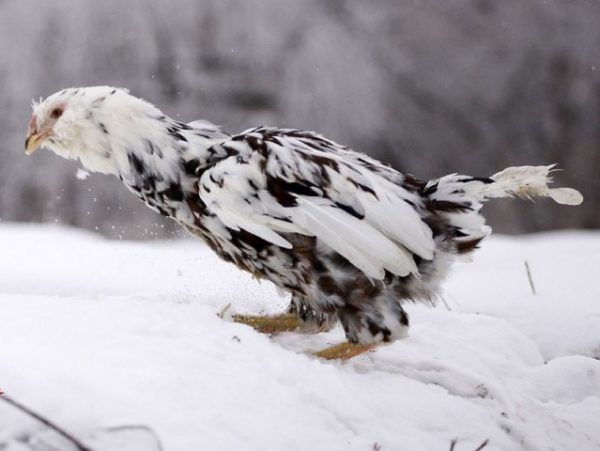

Lush plumage saves birds from frost
By the way, breeding purebred eagles is also considered a profitable enterprise. Farmers sell eggs for incubation, and chickens, and grown-up individuals. These chickens are unpretentious, easily adapt to a new place, and given the demand for the breed, the business will be profitable.
Growing Oryol calico chickens
In terms of productivity, birds of this breed belong to the meat - egg direction.
At one time, Oryol calico chickens were very popular far beyond the borders of Russia due to their unique adaptability, good meat and egg productivity, resistance and a high degree of adaptation to life in harsh weather and climatic conditions.
The pedigree of this breed is still unknown, but it is known that it was grown in Russia at the end of the 18th century, and as some historians suggest, the well-known Count A.G. Orlov-Chesmensky (whose surname, according to one of the versions and determined the name of this species). As a result, the Oryol breed quickly gained fame and recognition of poultry breeders, and by the end of the nineteenth century, these chickens were bred everywhere in Russia and even ended up in Europe, where they took part in several livestock exhibitions, showing excellent results.
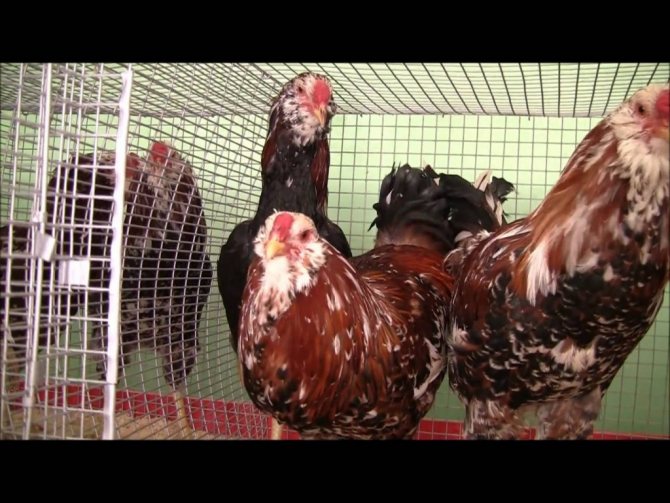

In 1914 the Oryol breed was standardized.
Alas, with the advent of new, more productive breeds, this one undeservedly receded into the shadows, since poultry farms (including Russian ones) switched to modern highly efficient crosses.
As a result, only individual amateurs began to breed calico chickens, and already at the beginning of the twentieth century, this type of bird became a rarity.
After the Great Patriotic War, a group of enthusiasts decided to recreate the Oryol breed. In the fifties, several purebred representatives were discovered in Germany, and work on the revival of calico chickens continued, as a result of which the breed gene pool was completely restored.
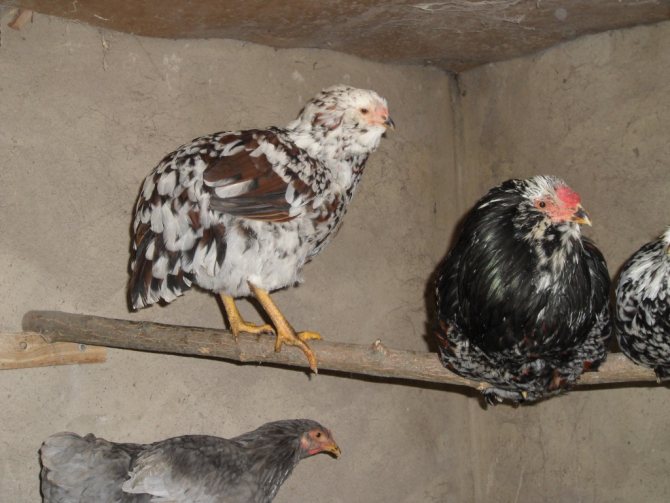

Chickens of the Oryol breed are quite large outwardly and reach a height of 60 centimeters. Birds have well-developed muscles. The body is strong, massive, and the neck is long, with lush plumage. The feathers in the upper part of the neck rise in the form of the nape, forming a kind of decoration. The birds' eyes are mostly orange and set rather deeply, and the massive hooked beak is bent downward, like in birds of prey.
The ridge is low, flattened and divided into two halves.
Owner reviews
Inna, 45 years old, Orel
It is not easy to acquire purebred orlovka producers: there are few reliable suppliers, and prices "bite". But still, I started doing this, and I'm not going to stop. The reason is obvious: the bird is extraordinarily impressive, beautiful and unusual. In addition, breeding and propagating an ancient, primordially our breed is quite a worthy goal. Yes, they are not very productive. But for meat and for obtaining eggs, I have simpler chickens. And these will be for the soul.
Anton, 61 years old, Mytischi
Oryol chickens have lived with me for a long time. He took grown-up chickens of the Russian line, but judging by their appearance and weight, he got "Germans" all the same. All the same, they are handsome and my favorites. The rooster is really angry. He commands the courtyard, does not allow other males to come close. But chickens (5 pieces) rush well. For the last three years I have taken out the kids. Their survival rate is not the best, but the breed qualities, in my opinion, are preserved. We managed to leave several pieces from the first brood for the tribe. I want to buy a couple of birds of a different color (I have ordinary chintz ones) for crossing and see the result.
Dmitry, 43 years old, Bryansk region
I cannot recommend this breed to beginners. There are many difficulties with breeding. The most annoying thing is that the chickens get sick and die. They fledge slowly, need heating, are very afraid of drafts and dampness. In general, the bird is by no means problem-free. But amateurs who already have experience can try it if there is a desire to tinker. Care, of course, will require more serious than for simple yard or modern meat and egg crosses. But the result will be luxurious, if possible. Chickens are simply gorgeous, a true decoration of the courtyard.
Origin story
Oryol chickens were bred over 200 years ago in Russia. The name of the breed was given in honor of Count Orlov-Chesmensky, who received magnificent birds by crossing a Malay chicken with a Russian eared. Oryol chickens were raised throughout the European territory of Russia until the middle of the 20th century. Gradually fashion for foreign breeds of birds and the consequences of the Second World War led to the fact that the Oryol chickens were practically exterminated.
Starting from the 50s, thanks to the efforts of domestic breeders Babushkin and Vinokurov, after 40 years of hard work, the old breed was restored. Oryol calico chickens now look in accordance with the pre-revolutionary description. The word "chintz" was added to the name because of the characteristic color of the plumage.
Frequent illnesses
Oryol chickens are not prone to disease at all, but there are prevention rules that must be followed. Lush plumage of chickens is threatened, therefore, it is necessary to especially carefully protect it from parasites. The most dangerous pests are ticks and chewing lice. Puff lice almost instantly deprive living creatures of the main advantage - their feathers.
Ticks carry dangerous infectious diseases that can become epidemic. In addition, the herd needs standard preventive vaccinations against common infectious diseases of chickens.
Oryol chickens exterior
The signs of the Oryol breed of chickens are determined by the following main indicators of the rooster:
- Tall - about 60 cm, wide vertical body.
- The head is of medium size and has a broad frontal bone. On the ridge there are small tubercles, between which there are bristly feathers. Strongly curved powerful beak rather short. Small earlobes are hidden by feathers. Deep-set eyes are reddish-amber in color. The superciliary arches are well defined. There are small red earrings. The birds are distinguished by the presence of pots and a noticeable beard.
- The neck is long with a slight bend. At the junction of the neck with the head or at the back of the head, swollen feathers form a spherical scruff. Closer to the shoulders, the neck is densely covered with feathers, therefore it seems thinner than at the base.
- Slightly convex, rounded chest.
- The upward and straight tail is medium in length. It is composed of beautiful feathers. The upper feathers rise slightly above the rest.
- The legs are powerful and long. The broad metatarsus are covered with shiny yellow scales.
Advantages and disadvantages
As well as any other breed of poultryCalico chickens have their pros and cons for home breeding.
pros
- The beautiful appearance gives the Oryol chickens expressiveness and originality.
- Males are endowed with fighting qualities, which arouses interest when observing life inside the house.
- Adults have good endurance and are adapted to large temperature extremes. They are not afraid of either heat or severe cold.
- Orlovki are distinguished by good meat productivity. Roosters can weigh up to 4.5 kg. Chickens gain about 3 kg of live weight. The meat, exquisite in taste, is reminiscent of game.
Minuses
Despite the fact that Orlovki lay in winter, the rather low egg production (150 eggs per year) makes it inappropriate to breed these chickens as layers.In addition, the chicken begins to lay late - by 7-8 months of age. Chicks during the growing period require special care, because they fledge poorly. The survival rate of young animals is low... Birds are demanding for quality food, which is typical for thoroughbred representatives of birds.
Analogs
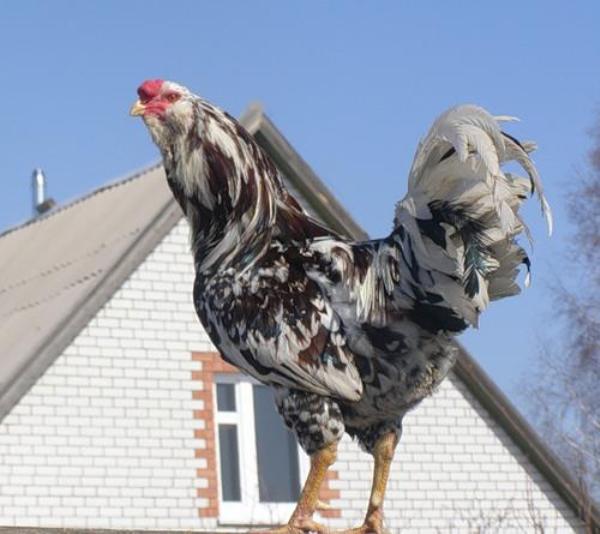

Oryol chickens are a kind of bird family. They are unique in nature, and it is very difficult to find a replacement for this species. If you cannot find representatives of this particular species, then you can replace them with similar ones. Of course, the analog won't be the desired copy.
Summing up, we can say with confidence that this type of chicken is characterized by high productivity and is one of the optimal ones for breeding. The downside of the breed is its pretentiousness in care and high requirements for keeping conditions.
Recommendations for keeping and feeding
Chicks need constant care as they grow and fledge slowly. They need warm and dry bedding. Grown up young animals need free space for movement and muscle development. As plumage appears, future hens and roosters can be distinguished. Females have noticeably lighter feathers. Like any other inhabitants of the chicken coop, the Orlovs need a roost. To protect against winter piercing winds, the room should be insulated. Given the fighting nature of these cocky birds, they should be kept separate from other breeds using partitions or cages. The nests in the house should be located at a height of 1 m from the floor.
Feeders and drinkers are selected so that they are suitable for short and curved beaks. Sand, small stones, mineral additives are constantly poured into the feeders. Birds need a high-quality diet, which should consist of root crops, grains, dairy products or ready-made complex mixtures. If you feed them with homemade compound feed, you should definitely add premixes and mineral dressings. Constantly clean water in drinking bowls is one of the conditions for the well-being of birds.
Character
Oryol calico chickens and roosters are very aggressive and quick-tempered - the genes of the fighting breed affect. Adult males, due to their large size, pose a threat to other inhabitants of the house. If such a rooster is greatly frightened, then he rushes even to the owners.
Because of this nature, the Oryol chickens are kept separately from other inhabitants of the chicken coop. If it is impossible to isolate these individuals in a separate room, you should keep the "orlovok" in cages.
Oryol calico chickens are characterized by a pugnacious and cocky disposition. They are aggressively opposed to their fellows. This should be taken into account by the owner when keeping several breeds at once, especially if they are in the same room.
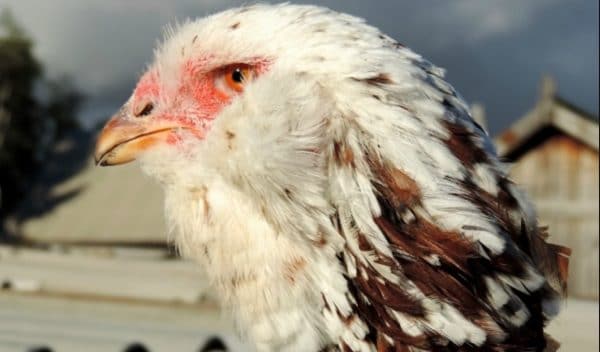

Oryol calico chicken
It is advisable to keep Orlovtsev separately. If this is not possible, then the birds are separated by an aviary or kept in cages, although they are lovers of long walks, which has a positive effect on their condition.
This bird cannot be called calm. Moreover, it is not suitable for beginners. It will be very difficult for them to care for chickens that are constantly showing aggression. The rooster, due to its impressive size, is a serious danger to humans or other domestic animals.
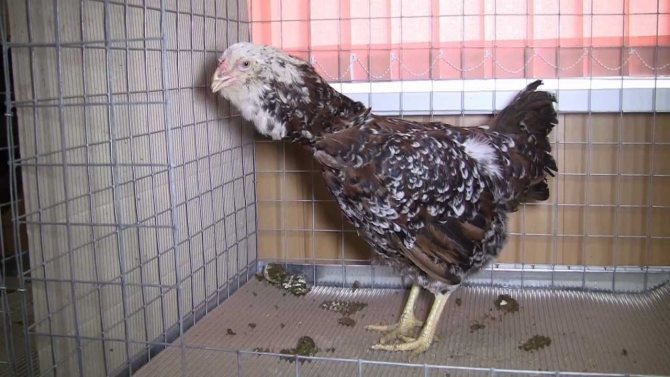

It is quite simple to provoke a male Orlovskaya chintz. It does not even need to be incited somehow, it is quite easy to scare away (not even on purpose), as it rapidly attacks even its master.
It is impossible to keep representatives of this breed together with another bird, as they will dominate, peck, attack other breeds. Therefore, Oryol calico must be kept separately.
Breeding and selection
Breeding the Oryol breed of chickens is a rather complicated process.To obtain purebred birds, one must pay attention to the growth of the rooster and the characteristic composition of the body. The comb must be of the correct shape, a spherical scruff is required on the neck. Legs without feathers are intended to confirm belonging to the described breed. As a result of crossing, the existing characters merge, therefore, individuals should be chosen, taking into account all the main indicators of the breed, including color. But even with the selection of birds of the same color, chickens may differ from their parents. For example, when crossing calico chickens, the offspring may be dark in color. Such young growth should be discarded.
For breeding and selection purposes, it is not recommended to use eggs of young hens that have reached the age of 1 year. Two-year-old layers are better suited. Large pinkish or creamy eggs without visible defects are laid in the incubator. In the incubator, it is necessary to strictly monitor the temperature regime.
Breeding purebred chickens becomes a profitable business that is based on the sale of eggs for breeding offspring, chickens or grown-up individuals. In addition, the owners of the farmsteads care not only about the practical benefits, but also about the aesthetic aspect of the process of growing a beautiful bird.
ferma.

